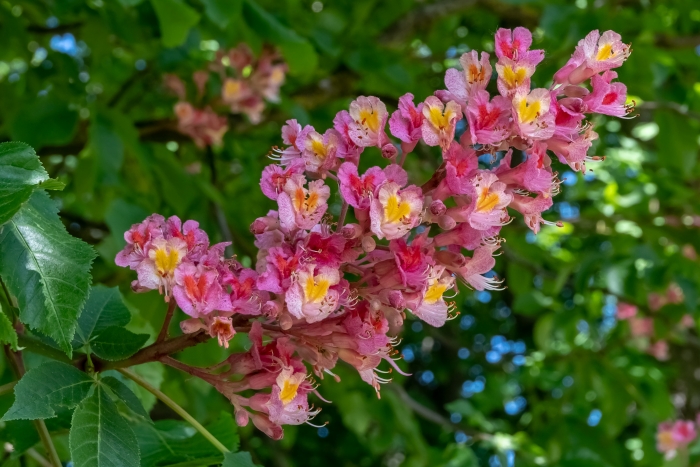Red Horse Chestnut
(Aesculus ×carnea)
Red Horse Chestnut (Aesculus ×carnea)
/
/

Isiwal
CC BY-SA 4.0
Image By:
Isiwal
Recorded By:
Copyright:
CC BY-SA 4.0
Copyright Notice:
Photo by: Isiwal | License Type: CC BY-SA 4.0 | License URL: https://creativecommons.org/licenses/by-sa/4.0 | Uploader: Isiwal | Publisher: Wikimedia Commons | Title: Aesculus_×_carnea_Kastanienallee_NDOÖ_058_Kastanienallee_Mai_2018-0626.jpg | Notes: Uploaded own work with UploadWizard |















































Estimated Native Range
Summary
Aesculus ×carnea, commonly known as Red Horse Chestnut, is a medium-sized deciduous tree that is an artificial hybrid between Aesculus pavia (Red Buckeye) and Aesculus hippocastanum (Common Horse Chestnut). It likely originated in Germany before 1820 and is not found in the wild. It typically grows up to 40 feet tall and 30 feet wide, forming a dense, rounded canopy. The tree is noted for its striking spring display of showy, red, upright panicle flowers, which are followed by leathery fruit capsules containing one to two large, shiny seeds, or "conkers," in the fall. The foliage consists of dark green, palmately compound leaves with five large, toothed leaflets that turn yellow-brown in autumn.
Red Horse Chestnut is valued for its ornamental flowers and dense foliage, making it a favorite for large gardens, parks, and as a street tree. It prefers full sun to part shade and grows best in moist, well-drained soils. While it is relatively low-maintenance, it can be susceptible to leaf blotch and horse chestnut scale. It is also less prone to the leaf miner that can plague A. hippocastanum. To maintain its health and appearance, regular watering during dry periods and occasional pruning to remove dead or diseased wood are recommended.CC BY-SA 4.0
Red Horse Chestnut is valued for its ornamental flowers and dense foliage, making it a favorite for large gardens, parks, and as a street tree. It prefers full sun to part shade and grows best in moist, well-drained soils. While it is relatively low-maintenance, it can be susceptible to leaf blotch and horse chestnut scale. It is also less prone to the leaf miner that can plague A. hippocastanum. To maintain its health and appearance, regular watering during dry periods and occasional pruning to remove dead or diseased wood are recommended.CC BY-SA 4.0
Plant Description
- Plant Type: Tree
- Height: 30-50 feet
- Width: 30-40 feet
- Growth Rate: Moderate
- Flower Color: Pink, Red
- Flowering Season: Spring
- Leaf Retention: Deciduous
Growth Requirements
- Sun: Full Sun, Part Shade
- Water: Medium
- Drainage: Fast, Medium, Slow
Common Uses
Bird Garden, Border Plant, Deer Resistant, Low Maintenance, Showy Flowers
Natural Habitat
Not found in the wild, prefers full sun to part shade, susceptible to leaf blotch and horse chestnut scale
Other Names
Common Names: Horse Chestnut , Ruby Red Horse Chestnut
Scientific Names: Aesculus ×carnea , Aesculus hippocastanum var. carnea , Aesculus rubicunda , Aesculus spectabilis , Aesculus ×rubicunda , Hippocastanum rubicundum , Pawia rubicunda
GBIF Accepted Name: